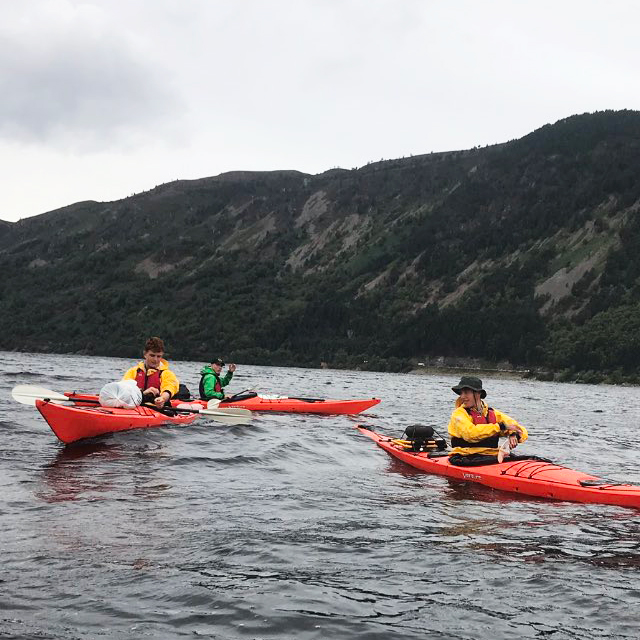
During the holidays 18 pupils took part in their Gold Duke of Edinburgh qualifying expedition, paddling across Scotland from coast to coast in an epic 60 mile journey over 5 days.
Duke of Edinburgh Manager and Head of Outdoor Education, Mr Steve Macpherson gave us this report:
As in previous years the Gold Duke of Edinburgh (DofE) groups travelled to Scotland for their qualifying expedition. Having practised their expedition skills in the Brecon Beacons over the Easter break the groups were as prepared as they could be to take on this challenge. This year we had 18 pupils taking part, a group of eight canoeing and two kayaking groups, one of six and one of four, and the aim was to paddle across Scotland from coast to coast. Their route would take them along The Great Glen Canoe Trail which follows the 96km of the Caledonian Canal from Corpach (Fort William) in the West to Dochgarroch (Inverness) in the East. Man-made sections of canal link the open waters of Loch Lochy and Loch Ness, and the slightly more sheltered waters of Loch Oich and Loch Dochfour.
After a long journey from Shiplake to Corpach near Fort William the participants were a little tired, however there was no time to rest. They had a meeting with their DofE assessor before sorting out their kit and equipment for an early start the following day. The weather forecast for the next day was not great so while the pupils were arranging their things, the staff team were discussing a plan B and C, just in case. Unfortunately the weather forecast was correct and we woke to a very wet and blustery day... plans B or C were looking favourable! To their credit the groups ignored the weather and got on with the task in hand and with relatively little fuss packed their boats and were soon ready to set off.
Day one was a day of two halves, the first along a sheltered stretch of canal and the second along the exposed shores of Loch Lochy to the campsite at the northern most point of the Loch. With the windy conditions it was looking doubtful that we would be able to reach this point...
As each group set off, a member of staff in a support kayak followed a suitable distance behind. Normally we would keep a much lower profile while supervising however due to the weather we stayed a little closer than normal. On arriving at Loch Lochy the effect of the wind was not as bad as we thought and the decision was made to continue. One by one the groups set off from the sheltered waters of the canal, around Bunarkaig Bay where Ospreys hunt for fish and along the edge of the Loch to the campsite at Laggan Locks. Our decision proved to be the right one, heavy rain and the occasional bouncy bit of water made the journey 'interesting' but didn't stop us. After a long hard day we arrived at our campsite and the Scottish weather even allowed a bit of sunshine to dry out soggy bodies while cooking an evening meal.
The following day the groups continued to travel north along the great glen, passing through Loch Oich before camping at Fort Augustus on the southern shores of Loch Ness. The weather gradually improved as the day went on and by the time we arrived at Loch Ness we had great views down the whole length of the Loch.
The next two days would be spent travelling along the shores of Loch Ness, camping at Foyers around half way up the Loch before continuing to Dochgarroch, just outside Inverness on the final day. Day three went without a hitch, and all the groups made good time to their campsite however the final expedition day was dry but with an unpredictable wind building from the South West. Loch Ness is 36km long and any wind from the south west tends to increase as it travels up the glen. As the wind increases it can often result in very turbulent waters at the northern most part of the Loch. Unfortunately for us the final part of our journey required us to cross from the east shore to the west before entering more sheltered Loch Dochfour and the final stretch of canal, once again a plan B and C were required. As we neared the head of the Loch the conditions stabilised and the decision was made to continue as planned and although it was challenging our alternative plans were not required. After entering the calm waters of Loch Dochfour a final break was definitely called for before the gentle paddle along a final stretch of canal to the extraction point.
With the poor weather this year's group was certainly challenged, however they remained positive and cheerful throughout. The Gold expedition is meant to be challenging but also rewarding and I hope that the pupils will look back on this journey with fond memories of a combined experience with friends in a wonderful part of the UK.
A special thanks goes to the teachers that supported the trip: Mrs Bayley, Mr and Mrs Adamson, Mr Elmore, Mr Griffiths and of course, Mr MacPherson who organised the expedition.





















